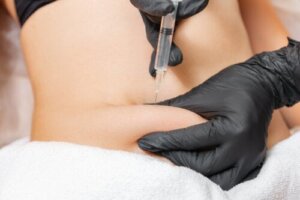7 Treatments to Combat Abdominal Sagging

Eliminating abdominal sagging, or flaccidity, without going under the knife is actually possible now. There are some minimally invasive methods designed to shrink sagging skin and enhance the formation of new collagen fibers.
Loose dermis often causes insecurities. Fortunately, some aesthetic treatments firm the tummy area if you combine them with a healthy diet.
The benefits of these methods are that you avoid all the risks of surgery and postoperative rest. In addition, within a few days, you’ll have an attractive abdomen. The choice of the procedure depends on a medical evaluation, in which the specialist determines the root cause of the abdominal sagging and which technique fits your needs.
What causes abdominal sagging?
A study published by the University of the South of Santa Catarina defines skin flaccidity as the loss of elastic connective tissue, a product of abrupt transformation of volume in the region.
When there’s no traction of the lining, it’s deformed and it’s difficult to return it to the original aspect. It’s also related to the decrease in collagen and elastin levels, which results in wrinkles.
Contrary to what many believe, abdominal sagging isn’t related to localized fat. Other factors that influence the dermal sagging of the abdomen are:
- A sedentary lifestyle
- Aging
- Poor nutrition
- Hormonal disorders
- Accelerated weight loss
- Weak abdominal muscles
- Cellular oxidation after childbirth
How to prevent abdominal sagging
Sagging in the abdomen is an aesthetic problem that you can prevent. The secret is to lead a healthy lifestyle and strengthen the muscles to help firm the skin.
It;s never too late to reverse your habits. But if you make the decision when a loose abdomen is evident, the recommended path involves treatments that don’t involve operations and that promote the production of collagen and elastin.
The 8 Foods that Provide the Most Collagen for Your SkinRead more here:
The best treatments to combat abdominal sagging
The techniques that we’ll now bring you all tone the abdominal area. The effects are long-lasting, as long as you complement them with sports, hydration, and foods rich in protein, fiber and that repair the muscles.

1. Mesotherapy
Mesotherapy is based on the application of intradermal or subcutaneous injections containing regenerative, moisturizing, and rejuvenating substances of the dermis. A dermatologist specifies the doses and applies them with needles of minimum size, directly into the flaccid points.
The change is visible in the short term. There are even people who notice them from the first infiltrations.
It’s advisable to visit a minimum of 4 times.
2. Carboxytherapy
Carboxytherapy involves the percutaneous administration of medicinal carbon dioxide. The compound is provided by means of injections on flaccid skin to promote blood flow and increase cutaneous oxygenation. The punctures have a biochemical reaction similar to the body’s response when you exercise it.
Apart from helping to eliminate flaccidity, carboxytherapy fades stretch marks and enhances fibroblast production. It requires at least 4 sessions. However, the physician adjusts the therapies according to the needs of each patient.
3. Kotz stimulation
This method is also known as electrotherapy or Russian wave stimulation. The name comes from the scientist Yakov Kotz.
In the aesthetic field, this treatment is recommended to produce muscular hypertrophy, as explained in a paper published on the Academia platform. The text notes that stimulation by Russian currents tones flaccid muscles and modulates body contours.
For electrotherapy, the physician places electrodes on the skin in order to emit current at minimum intensity. The discharges stimulate the muscles, causing them to contract and improve tone and firmness.
A minimum of 5 sessions per week is required, in 25 to 40 minute intervals. Firming creams are allies for the effectiveness of the process.
4. Radiofrequency
Radiofrequency is based on the use of equipment that gives off intense heat, which compacts the collagen fibers in the abdomen and promotes the formation of new tissue.
The device is slid over the abdominal region at a temperature no higher than 40 °C. According to the condition of each patient, at least 3 sessions could be scheduled every 15 days.
After the first 21 days of therapy, you start to see a smoother skin. The result lasts up to 3 years.
5. Cryolipolysis
Cryolipolysis consists of the use of cold to reduce the thickness of the dermis and surrounding tissues without causing damage. The Revista Argentina de Dermatología argues that the use of cold in medicine has a long history, especially for its therapeutic capacity in different skin pathologies.
In particular, liquid nitrogen at low temperatures causes necrosis of the damaged lining, favoring the smoothness of the skin. This treatment offers progressive results, and produces maximum results 2 months after the sessions.
6. Electrolypolisis
With electrolypolisis therapies, you benefit the blood circulation and contribute to the production of essential hormones to tone the skin structure. The technique corrects body volume, especially in difficult areas.
The number of sessions and the duration vary for each patient. Experts say that there’ll be optimal results if you combine electrolypolisis with muscle strengthening programs.
To apply the method, the specialist implants pairs of fine needles in the abdominal region and delivers low currents. The method uses topical substances that favor transmission.
7. Exercises
This is the oldest and least invasive treatment, but with good results against abdominal sagging. Thanks to sports training, you extend the effect of other minimally invasive aesthetic techniques.
Try routines that include strength and cardio exercises. The plank abdominals provide great changes in this area of the body.

Get to know: What Exercises does Jennifer Lopez Include in Her Routine to Maintain a Slim Figure?
Are there side effects or contraindications in treatments for abdominal sagging?
Generally, these treatments are applied by dermatologists and plastic surgeons. Not all countries allow beauticians to perform these treatments. If they do, medical supervision is essential, as they’ll be handling delicate substances and equipment.
Among the secondary reactions of this kind of technique are the risk of infection, skin reddening, hematomas at the injection points, and pain.
On the other hand, although they aren’t very invasive procedures, complications could arise if the patient hides the fact that he or she is dealing with conditions such as the following:
- Arrhythmias
- Epilepsy
- Heart failure
- Uncontrolled hypertension
- Coagulation disorders
- Skin infections near the abdominal area
When is surgery advisable?
While the idea is to get rid of flaccidity without resorting to the operating theater, there are cases when surgery is appropriate. It’s called abdominoplasty and uses advanced technology to restore abdominal firmness.
According to the advice of the Colombian Society of Plastic, Aesthetic and Reconstructive Surgery, the intervention is appropriate for people with excess skin and fat. However, in the case of women, it’s advisable to undergo surgery if they don’t plan to become pregnant again.
All cited sources were thoroughly reviewed by our team to ensure their quality, reliability, currency, and validity. The bibliography of this article was considered reliable and of academic or scientific accuracy.
- Abdominoplastia. Sociedad Colombiana de Cirugía Plástica Estética y Reconstructiva. Colombia. https://www.cirugiaplastica.org.co/procedimientos/cirugias-plasticas-esteticas/cirugias-corporales/abdominmoplastia/
- Báez M. Corriente de estimulación rusa Kotz. Academia. Estados Unidos. https://www.academia.edu/35206394/CORRIENTE_DE_ESTIMULACI%C3%93N_RUSA_KOTZ
- Cárdenas Camarena L, Dorado C, González H, Guerrero MT, Sander M. Rol de la carboxiterapia en la mejora de la calidad de piel antes de ritidoplastia. Cirugía Plástica Ibero-Latinoamericana. Vol. 46. Núm. 1. pp. 99-106. España; 2020. https://scielo.isciii.es/pdf/cpil/v46n1/1989-2055-cpil-46-01-0099.pdf
- Electrolipólisis. Sociedad Española de Medicina Estética. https://www.seme.org/pacientes/tecnicas-y-tratamientos/electrolipolisis
- Ferraro GM, Torreiro A, Lafrenz M. Criolipólisis plana: efectos sobre el tejido adiposo en el área subumbilical de 38 pacientes. Observaciones clínicas de su aplicación. Revista Argentina de Dermatología. Vol. 98. Núm. 1. Argentina; 2017. http://www.scielo.org.ar/scielo.php?script=sci_arttext&pid=S1851-300X2017000100002
- Fibroblasto. National Human Genome Research Institute. Estados Unidos; 2022. https://www.genome.gov/es/genetics-glossary/Fibroblasto#:~:text=Un%20fibroblasto%20es%20un%20tipo,marco%20estructural%20de%20los%20tejidos.
- Pacheco Gonçalves V, Scur N. Caso de estudio: Uso de radiofrecuencia bipolar en flacidez de tejidos abdominales. Universidad del Sur de Santa Catarina. Brasil; 2012. https://silo.tips/download/estudo-de-caso-uso-da-radiofrequencia-bipolar-em-flacidez-tissular-abdominal-cas
This text is provided for informational purposes only and does not replace consultation with a professional. If in doubt, consult your specialist.








